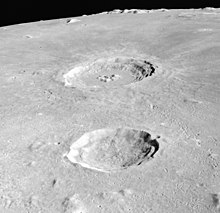Autolycus is a lunar impact crater that is located in the southeast part of Mare Imbrium. The crater is named after the ancient Greek astronomer Autolycus of Pitane.[1] West of the formation is Archimedes, a formation more than double the size of Autolycus. Just to the north is Aristillus, and the outer ramparts of these two craters overlap in the intermediate stretch of the lunar mare.
 Lunar Orbiter 4 image | |
| Coordinates | 30°42′N 1°30′E / 30.7°N 1.5°E |
|---|---|
| Diameter | 39 km |
| Depth | 3.4 km |
| Colongitude | 358° at sunrise |
| Eponym | Autolycus |



Description
editThe rim of Autolycus is somewhat irregular, although generally circular overall. It has a small outer rampart and an irregular interior with no central peak. It possesses a light ray system that extends for a distance of over 400 kilometers. Due to its rays, Autolycus is mapped as part of the Copernican System.[2] Some of the ray material appears to overlay the flooded floor of Archimedes, and thus Autolycus is older than Archimedes. Aristillus (to the north), however, has rays that overlay both Autolycus and Archimedes, and thus it is the youngest of the three craters.
The first man-made impact upon the Moon was when the Luna 2 probe crash-landed just to the west-southwest of the crater rim on September 13, 1959,[3] according to the claim of one Hungarian astronomer who claimed to see an explosion of dust.
Satellite craters
editBy convention these features are identified on lunar maps by placing the letter on the side of the crater midpoint that is closest to Autolycus.
| Autolycus | Latitude | Longitude | Diameter |
|---|---|---|---|
| A | 30.9° N | 2.2° E | 4 km |
| K | 31.2° N | 5.4° E | 3 km |
Notes
edit- ^ "Autolycus (crater)". Gazetteer of Planetary Nomenclature. USGS Astrogeology Research Program.
- ^ Wilhelms, Don E.; With Sections By Mccauley, John F.; Trask, Newell J. (1987), The geologic history of the Moon, USGS Professional Paper: 1348. Plate 11: Copernican System, doi:10.3133/pp1348
- ^ Wilhelms, Don (1987). "1. General Features" (PDF). Geologic History of the Moon. United States Geological Survey. p. 12. Archived from the original (PDF) on March 7, 2006. Retrieved 2017-02-22.
{{cite book}}:|work=ignored (help)
References
edit- Andersson, L. E.; Whitaker, E. A. (1982). NASA Catalogue of Lunar Nomenclature. NASA RP-1097.
- Blue, Jennifer (July 25, 2007). "Gazetteer of Planetary Nomenclature". USGS. Retrieved 2007-08-05.
- Bussey, B.; Spudis, P. (2004). The Clementine Atlas of the Moon. New York: Cambridge University Press. ISBN 978-0-521-81528-4.
- Cocks, Elijah E.; Cocks, Josiah C. (1995). Who's Who on the Moon: A Biographical Dictionary of Lunar Nomenclature. Tudor Publishers. ISBN 978-0-936389-27-1.
- McDowell, Jonathan (July 15, 2007). "Lunar Nomenclature". Jonathan's Space Report. Retrieved 2007-10-24.
- Menzel, D. H.; Minnaert, M.; Levin, B.; Dollfus, A.; Bell, B. (1971). "Report on Lunar Nomenclature by the Working Group of Commission 17 of the IAU". Space Science Reviews. 12 (2): 136–186. Bibcode:1971SSRv...12..136M. doi:10.1007/BF00171763. S2CID 122125855.
- Moore, Patrick (2001). On the Moon. Sterling Publishing Co. ISBN 978-0-304-35469-6.
- Price, Fred W. (1988). The Moon Observer's Handbook. Cambridge University Press. ISBN 978-0-521-33500-3.
- Rükl, Antonín (1990). Atlas of the Moon. Kalmbach Books. ISBN 978-0-913135-17-4.
- Webb, Rev. T. W. (1962). Celestial Objects for Common Telescopes (6th revised ed.). Dover. ISBN 978-0-486-20917-3.
- Whitaker, Ewen A. (1999). Mapping and Naming the Moon. Cambridge University Press. ISBN 978-0-521-62248-6.
- Wlasuk, Peter T. (2000). Observing the Moon. Springer. ISBN 978-1-85233-193-1.
External links
edit- Media related to Autolycus (crater) at Wikimedia Commons